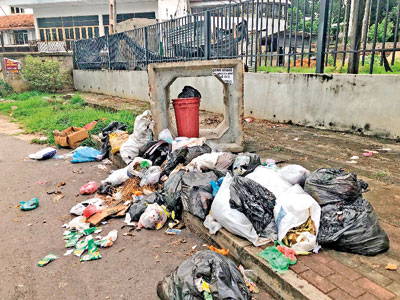Sunday Times 2
Should Sri Lanka be worried about nanoplastic?
Plastic is everywhere and has become an integral part of our everyday life. Over the last two decades or so, the consumption of plastic has been drastically increased around the world due to its versatility, lightweight, ease of molding, strongness, pliability, chemical and biological inertness, and economical production cost.

Plastic waste piling up on a municipal road
Plastic inspires technological innovations and is employed in a wide spectrum of fields, including transportation, construction, communication, food and drug, medicine, and agriculture. Interestingly, a world without plastic is now unfathomable. While more than 300 million tons of plastic are produced annually, millions of tons of plastic waste are also disposed across the world. Unfortunately, this amazing material is at the dawn of one of the worst human-made environmental disasters of all time.
Plastic waste is not restricted to inland; it has now been contaminated in aquatic systems, including freshwater, seas and deep oceans. Surprisingly, an overwhelming amount of over 70% of marine plastic waste is originated from inland sources that enter the oceans every year from the coastal countries including China, Sri Lanka, Thailand, Egypt, Nigeria, Bangladesh, Vietnam and Malaysia. The largest amount of plastic waste comes from the packing industry, where the majority generated by households and the rest by industries. Common plastic waste includes shopping bags, lunch sheets, bottles, toys, buckets, crockeries, food wrappers and cigarette filters.
Standard plastic is resistant to biodegradation; when disposed it tends to accumulate in the natural environment without being decomposed. Consequently, seashores and landfills covered with plastics such as bags or bottles remain unaffected for decades or even centuries. The permanent and affordable solution for the elimination of plastic waste is the combustion, which only to release harmful compounds and gases such as carbon dioxide and carbon monoxide into the atmosphere giving more environmental headaches. Once disposed in the environment, plastics are likely to pollute the land and aquatic ecosystems near permanently.
What is nanoplastic?
A particular type of plastic called “microplastic” has caught the attention of the scientific community since 2004 and it is now believed that the real potential environmental hazard of plastic arises from this microplastic. Environmentalists have been vocal about how microplastic pollution is killing a large number of animals, especially marine species such as fish and sea turtles as microplastic can be easily ingested and get stuck in their digestive system.
Microplastics are minute particles such as fragments, beads and fibres, into which large plastic materials or synthetic polymers break down. It was reported that the plastic particles accounted for about 80% of marine debris and over 90% of floating particles.
Generally, plastic particles smaller than 5 millimetres in size are considered as microplastics. However, there is an apparent ambiguity defining the size limits of microplastic; notably, there is no precise lower limit to the size of the microplastic. Recently, scientists have started calling the term “nanoplastic” or “plastic nanoparticles” for particles smaller than 0.1 micrometers.
Unlike microplastics, nanoplastic is extremely difficult to isolate from their environment via simple separation methods such as filtration. Scientists, researchers and environmentalists are more concerned about nanoplastic than ever due to its small size.
This ultrafine nanoplastic has distinct properties such as its ability to transfer fast and far, easily enter the food chain and move up all the way to human beings and also can penetrate through tissues and organs of living organisms such as plants, animals and humans. Human exposure and toxicity to nanoplastic can be through our diet, inhalation and skin. The main issue with nanoplastic is that we know very little about it, hence the adverse effects associated with exposure we do not know yet. Importanlty, nanoplastic is considered extremely hazardous and could be a “silent killer.”
Why should Sri Lanka be concerned about nanoplastic?
According to Sri Lanka’s Central Environment Agency (CEA), we import 0.2 million metric tons of raw plastic materials: about 70% is for daily use and the other 30% is for export purposes. Interestingly, only 2,400 metric tonns of plastic waste is collected daily out of 3500 metric tonns of solid plastic waste in the western province indicating the enormous amount of plastic waste piling up in Sri Lanka.
Moreover, Sri Lanka is also amongst the world’s top five plastic polluters. As an island, Sri Lanka is inherited with a diverse range of marine species both plants and animals. Being one of the world’s leading coastal polluters, our marine ecosystems, freshwater bodies, and vegetation might have already been conquered by nanoplastic without our knowledge. Sadly, given the novelty of this silent killer, its full contamination levels and toxicological assessments are yet to be fully explored. Therefore, the complete evaluation of this emerging hazard needs to be carried out promptly, before it becomes detrimental to our beautiful marine ecosystem and ultimately to our entire society.
How do we address this
nanoplastic issue?
Understanding the amounts of nanoplastic present in our environment and its toxicological effects requires a broad collaborative effort from the relevant government agencies, universities and professionals, including academics, scientists, waste management authorities, engineers, environmentalists, and toxicologists.
Continued communication with brainstorming discussions and active engagement among these experts will allow identifying the true origins of nanoplastic, risks posed by nanoplastic, nanoplastic waste management strategies, and capturing of nanoplastic. However, the immediate solution for this issue is to reduce and cut out unnecessary plastic use including single-use items and try substituting plastics whenever we can.
(The writer is a senior Biosystems Technology lecturer at the University of Sri Jayewardenepura)

